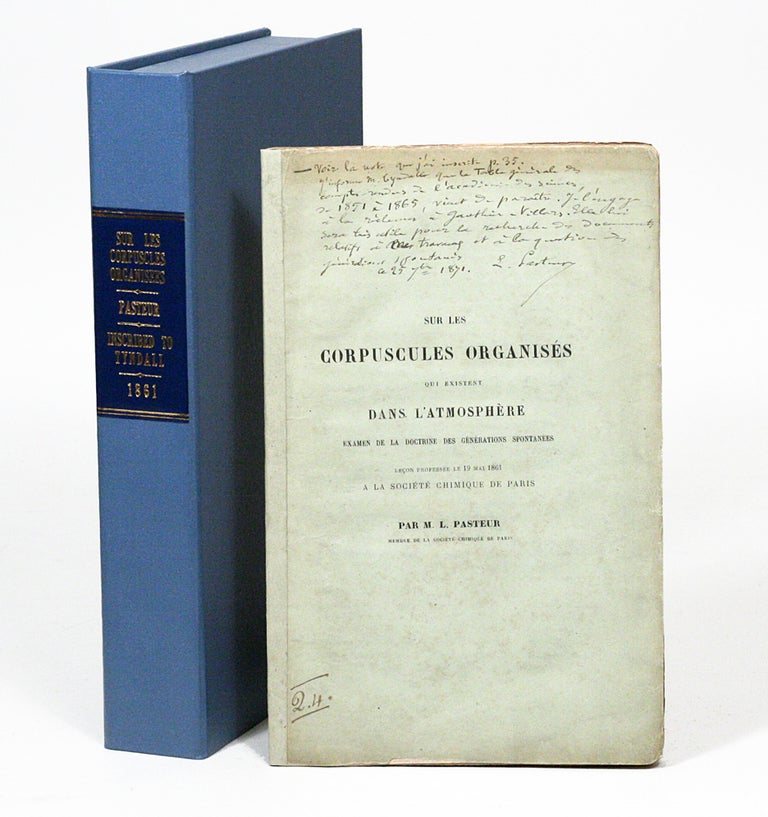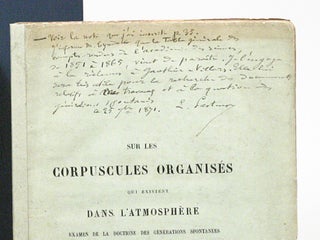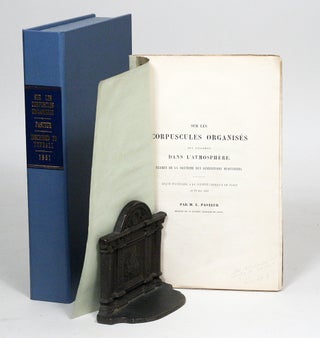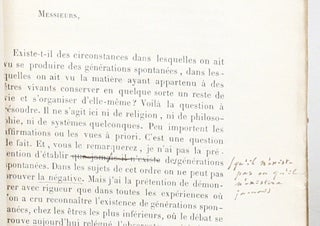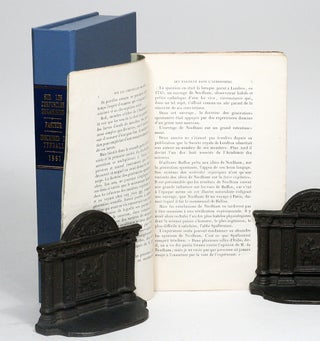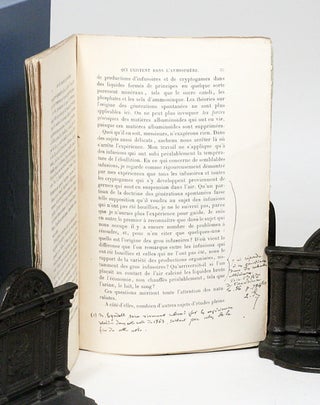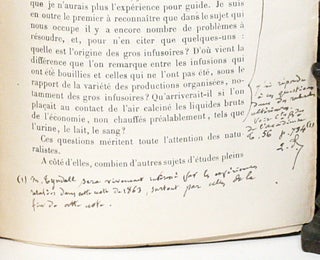Sur les corpuscules organisés qui existent dans l’atmosphère: Examen de la doctrine des générations spontanées (1861)
“If Pasteur was a genius, it was not through ethereal subtlety of mind. Although often bold and imaginative, his work was characterized mainly by clearheadedness, extraordinary experimental skill, and tenacity — almost obstinacy — of purpose. … [The effect of his efforts] to discredit the theory of spontaneous generation … was due less to profound conceptual originality than to experimental ingenuity and polemical virtuosity.” — Dictionary of Scientific Biography.
PRESENTATION AND ASSOCIATION COPY OF THE RARE AUTHOR’S OFFPRINT OF PASTEUR’S FAMOUS LECTURE DISCREDITING THE THEORY OF SPONTANEOUS GENERATION, WITH HIS AUTOGRAPH NOTES TO FELLOW SCIENTIST JOHN TYNDALL.
Spontaneous generation — the theory that living organisms are routinely created from inanimate matter — goes back to ancient times. Although the theory had been cast into doubt by the observations and experimental work of Redi, Spallanzani, and others in the seventeenth and eighteenth centuries, it proved remarkably hard to kill, and still had many distinguished adherents in the early nineteenth century. In part its persistence was due to the rise of microscopy, which had revealed a host of previously unknown organisms, with no apparent origin, in soil, pond water, and other natural environments. Where had these organisms come from, if they had not been spontaneously generated? In part it was due to bona fide disputes over experimental techniques, with opponents of the theory arguing that demonstrations of the spontaneous generation of microorganisms in supposedly sterile nutrient media were merely the result of contamination or inadequate sterilization; and proponents of the theory arguing that the failure of microorganisms to grow in sterilized nutrient media in sealed flasks was the result either of damage to some vital ingredient in the medium resulting from the heat-sterilization process, or of the fact that the medium did not have access to oxygen or to some other factor in the air that was necessary to support spontaneous generation. See generally John Farley, The Spontaneous Generation Controversy from Descartes to Oparin (Johns Hopkins 1977).
That is where matters rested when “[Felix] Pouchet launched his attempt to establish the doctrine of spontaneous generation on the basis of irrefutable experiments. Pouchet, a respected naturalist from Rouen and a corresponding member of the Académie des Sciences, published in 1859 his long and controversial [Héterogenie ou traité de la génération spontanée], which created a sensation in France and probably stimulated the Académie des Sciences to institute the Alhumbert Prize in 1860 for the best ‘attempt, by well conducted experiments, to through new light on the question of so-called spontaneous generations.’” Dictionary of Scientific Biography (“DSB”). Pasteur won the prize with the experimental work described in his lecture, which “provided the final experimental coup de grâce” to spontaneous generation, at least in France, although “the debate ... dragged on for another twenty years in Britain and Germany ….” (Farley, op. cit.).
Pasteur had been led to his interest in spontaneous generation by his prior work on fermentation. Having determined that fermentation was caused by the action of living organisms, he moved on to wondering where those organisms came from — whether they were spontaneously generated or were the descendants of parent-organisms already present in, or introduced from the air into, the substance being fermented. Beginning in 1859, he conducted a series of experiments designed to eliminate the methodological quibbles that had arisen over earlier results, and to resolve the spontaneous generation question once and for all. Among these were the famous experiments demonstrating that no microorganisms would grow in sterilized nutrient media held in open, swan-necked flasks. (The flasks were open to ensure that the medium had access to air; the narrow, curved swan necks trapped dust particles in the air that might introduce new microorganisms into the medium.) In an ingenious coda to the experiment that demonstrated that the medium had not been damaged by sterilization, he found that “if one of the curved necks were detached from a hitherto sterile flask and placed upright in it, vegetative growths appeared in a day or two.” ( DSB).
Pasteur’s results were discussed in a lecture he delivered in 1861 to the Société chimique de Paris. The lecture was originally published in the 1861 volume of the Société’s annual publication “Leçons de chimie et de physique,” together with a number of other lectures delivered that year. The item offered here is an author’s offprint from the Leçons volume, containing only the Pasteur lecture, with the same page count and layout of lines on each page as in the Leçons volume, but with the pages renumbered from 1-36. (The lecture proper was 34 pages long and printed on pages 3-36 of the offprint; page numbers 1 and 2 were assigned to the title page and its verso.) The experiments were also described in a series of lectures delivered before the Académie des Sciences, and an expanded description was incorporated into Pasteur’s famous paper “Mémoire sur les Corpuscules Organisés qui existent dans l’Atmosphère” (PMM 336(c)), which was published in Annales des sciences naturelles, and subsequently in Annales de chimie et de physique.
An important presentation and association copy:
This copy of the offprint includes lengthy autograph notes added by Pasteur in September 1871 that were addressed to John Tyndall, an eminent Victorian-era scientist who went on to perform important research of his own on the spontaneous generation question. (On Tyndall’s life and achievements, see generally Roland Jackson, “The Ascent of John Tyndall: Victorian Scientist, Mountaineer, & Public Intellectual” (Oxford 2018).) Pasteur’s autograph notations on the offprint include a lengthy note in French on the front wrapper (signed “L. Pasteur”), one on page 35 (initialed “L.P.”), and a marginal correction on page 3 (i.e., the first page of the lecture proper).
--On page 3 of the offprint as originally printed, Pasteur noted that he did not claim to be able to establish that spontaneous generation never occurs, since he cannot prove a negative. Instead, he claimed to be able to show rigorously that in all cases where spontaneous generation was thought to have been shown, the observer had been the victim or illusions or errors that he did not notice or was unable to avoid. Pasteur’s marginal note changed the description of the proposition that he did not claim to prove, from the spontaneous generation “never exists,” to spontaneous generation “does not exist and never will exist.”
--The note on the front wrapper calls Tyndall’s attention to the note on page 35, informs him that the index of the journal Comptes-rendus de l’Académie des Sciences for the period 1861-65 had just been published, offers to obtain it for him, and states that Tyndall will find the index useful for learning about Pasteur’s work in this area. The note is dated September 25, 1871.
--Next to a passage on the bottom of page 35 that identifies various questions that “deserve all the attention of naturalists,” Pasteur notes that he answered these questions in his later research, and provides a citation to a later paper by Pasteur in the Comptes Rendus.
On John Tyndall:
Tyndall was an accomplished scientist with wide-ranging interests. “[H]is work on diamagnetism, involving the effects of compression on hundreds of crystalline substances (1851-1856), led to the study of Penrhyn slate and the problem of “slaty cleavage” (1854-1856). Generalizing from the effects of pressure on slate led him to the study of glacial movement (1856-1859); in turn, glaciers fostered a passion for mountaineering and a fascination for what was to become his major work–the effects of solar and, later, heat radiation on atmospheric gases (1860–1870). He then considered the scattering of light particles in the atmosphere[,] the “Tyndall effect[,]” and explained the blue color of the sky (“Rayleigh scattering”). The scattering of sunlight by dust particles … led him to consider means of destroying airborne organic matter by heat; this in turn kindled his interest in the case against spontaneous generation (1870-1876) and brought him to the defense of Pasteur. This formidable capacity to move from electromagnetism through thermodynamics and into bacteriology was the hallmark of Tyndall’s genius. No less formidable were his talents in describing, with charm and lucidity, the phenomena of physics to large audiences.” (DSB). Incidentally, Tyndall’s interest in dust also led him to propose to Darwin an evolutionary explanation for the existence of nasal hair. Jackson, op. cit., p. 275. A summary by Tyndall of his own experimental work on spontaneous generation is reprinted in James Bryant Conan, ed., “Pasteur’s and Tyndall’s Study of Spontaneous Generation” (Harvard Case Histories in Experimental Science, Harv. Univ. Press 1953).
During a trip abroad in 1872, Tyndall stopped off in Paris and “spent an hour with Pasteur, whose experiments on fermentation had much impressed him.” Jackson quotes a letter now in the archives of the Royal Institution of Great Britain, written by Pasteur to Tyndall in October 1871 — just a month after he had added his notes to Tyndall to the offprint offered here — in which Pasteur “wrote flatteringly that with Tyndall’s ‘rare genius, your brilliant imagination, your incomparable talent of explaining, you will provide a great service.’” (Jackson, op. cit., p. 297-98). Tyndall returned the compliment, writing in 1878 that “clearness, strength and caution with consummate experimental skill for their minister were rarely more strikingly displayed than in this imperishable essay [Pasteur’s Mémoires].” Farley, op. cit., p. 100.
OFFPRINT FROM: Société chimique de Paris. Leçons de chimie et de physique professées en 1861. Paris: Ch. Lahure et Cie, [1862]. Original green wrappers rebacked; custom box. Mild browning to wrappers, p.35/36 technically detached but stable when inserted into gutter.
THE OFFPRINT ITSELF IS EXCEEDINGLY RARE - WE COULD ONLY CONFIRM THE EXISTENCE OF A HANDFUL OF COPIES; THIS SIGNED AND INSCRIBED COPY UNITING TWO TOWERING FIGURES OF 19TH-CENTURY SCIENCE IS A REMARKABLE SURVIVAL.
Price: $25,000 .


